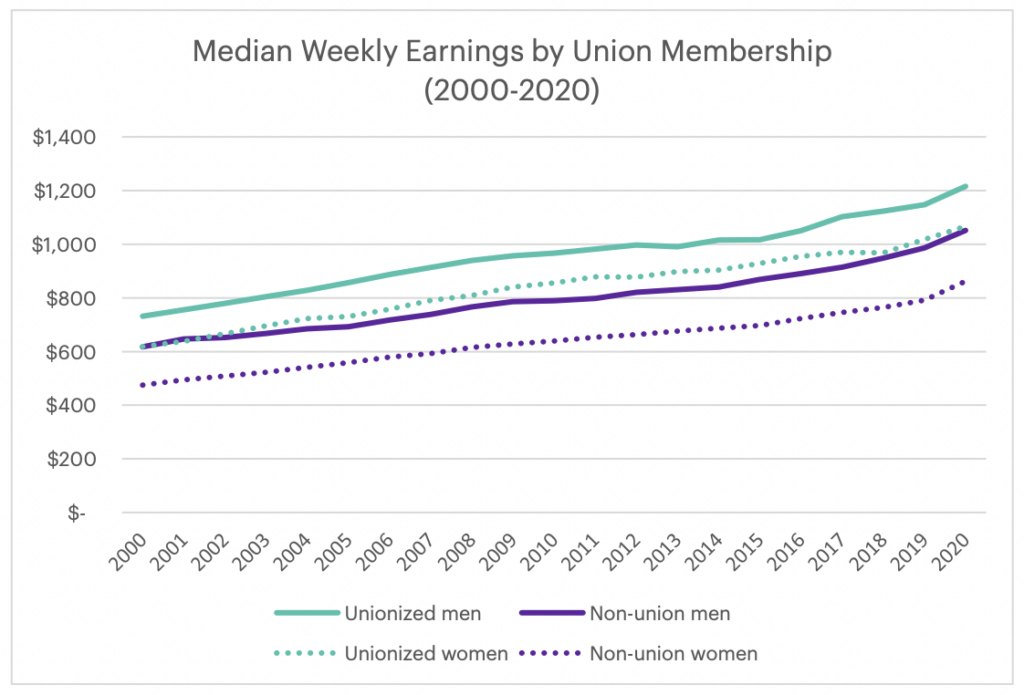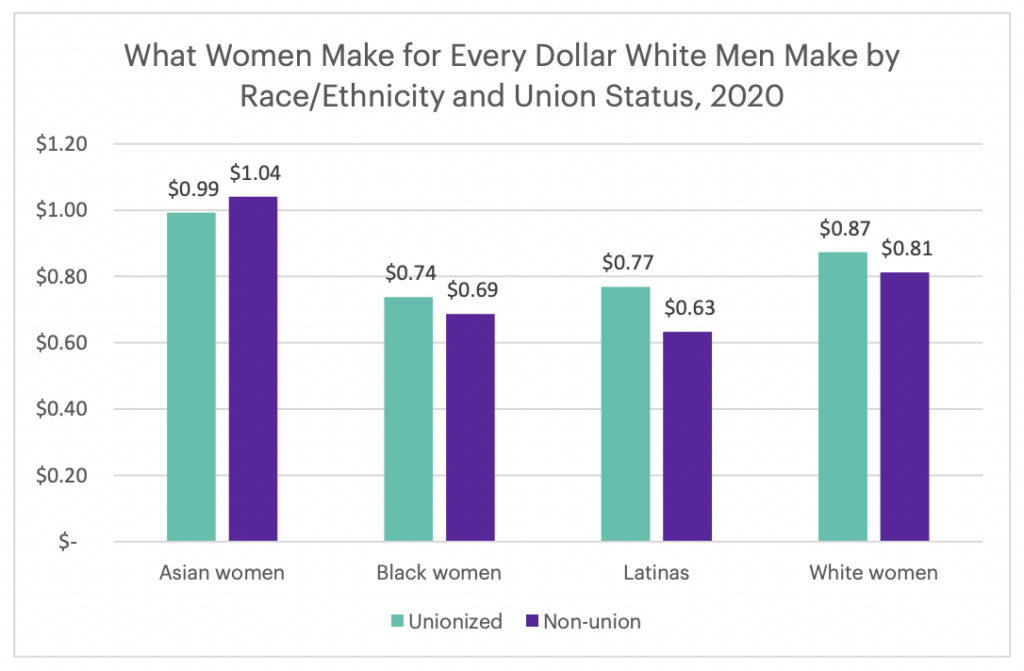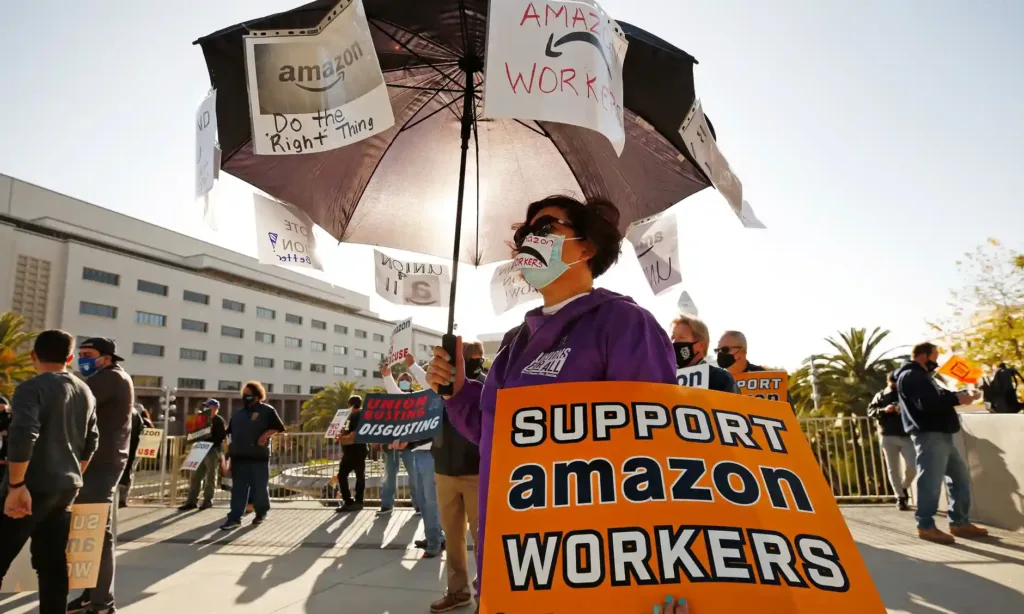“Union pay transparency helps to interrupt a culture of secrecy around pay that often makes it extremely difficult for individual workers to prevent or discover disparities.”
Weekends, lunch breaks, paid vacations, overtime pay. Unions have fought long and hard against big business for these and many more benefits that are now considered basic rights. But did you know union membership also decreases the gender wage gap?
Women in unions earn higher and more equal wages, have greater access to affordable health benefits and are more likely to have the right not to be fired without cause, according to the recently-released fact sheet, “Unions Are Good for Women,” by the National Women’s Law Center (NWLC).
According to NWLC, unionized women working full time typically make $1,067 per week—24 percent or $205 more than women workers not in unions, who typically make $862 per week.

But unionized women also experience a lower gender wage gap than nonunionized women. While nonunionized women working full time make an average of 82 cents on the dollar earned by white men, unionized women make 88 cents to the white man’s dollar. This benefit persists across racial groups.

NWLC attributes lower wage gaps for unionized women to greater wage transparency, standardization in collectively bargained wages, the availability of formal grievance processes and union representation to address complaints regarding wages. The report explains:
“Union pay transparency helps to interrupt a culture of secrecy around pay that often makes it extremely difficult for individual workers to prevent or discover disparities. In one powerful example, Wisconsin teachers began to see a gender wage gap—where there had been none before—after the state passed Act 10, a bill weakening teachers unions’ ability to set pay. Before Act 10 passed in 2011, teacher salaries were set on a publicly available schedule; after Act 10 passed, unions could only negotiate base salaries, and further negotiations were left to individuals. Without collective union negotiation power and wage transparency, women began to fall behind.”

Despite the longstanding and persistent attempts by big business and Republican politicians to destroy unions, the public is more supportive of collective organizing now than in many years. According to a recent Gallup poll, 65 percent of people in the United States approve of unions as of 2020—the highest approval rate since 2003. Women and people of color are even more likely to support unions—at 67 percent and 70 percent respectively.
And while 83 percent of Democrats approve of unions, a significant number of Republicans support them as well—45 percent, reports Gallup. There’s no denying collective bargaining enables unionized people to win economic security for themselves and their families.
Republican attacks on collective organizing, however, have taken a toll on union membership in recent decades— more for men than women. Whereas men’s union membership has dropped 27.6 percent in the last 20 years, women’s union membership has dropped only 7.9 percent overall. Today about one in 10 women workers are in unions and almost half of unionized workers (46.8 percent) are women. As a result, “women are increasingly at the center of the labor movement,” says NWLC.
Part of women’s robust union membership is due to their strong representation in highly unionized government work and in the education and health services sector where union membership actually increased by 6.3 percent between 2000 and 2020. Men, on the other hand, are concentrated in sectors where union rates are dropping the fastest, such as construction (27.4 percent) and manufacturing (43 percent).
Despite the significant benefits of unions for workers, Republican politicians and judges have been chipping away at the right to unionize for years. Union workers in the private sector have the National Labor Relations Act, enacted in 1935 to protect the right to organize, but this law has been significantly eroded over time and is not well enforced. Today, employers violating the law face only minimal penalties.
NWLC argues that corporations mount “sophisticated campaigns to scare their employees away from voting in their own interests,” giving the example of the recent campaign by Amazon workers to organize a union in Bessemer, Alabama. “The company went so far as to change the traffic light pattern outside the warehouse to make it less likely that employees would be able to talk to union organizers,” says NWLC.

Meanwhile, public sector employees have no federal protection to organize and the U.S. Supreme Court has steadily weakened collective bargaining rights.
“Our labor laws are outdated,” says NWLC. The organization is calling for new federal legislation such as the Protecting the Right to Organize Act and the Public Service Freedom to Negotiate Act that would strengthen workers’ rights to successfully organize unions and fight for better working conditions, especially for women.

You may have seen the bumper sticker saying “Unions: The Folks That Brought You The Weekend.” To celebrate Labor Day today, we need a new bumper sticker saying “Unions: The Folks Increasing Wage Equity for Women.”
Up Next:





